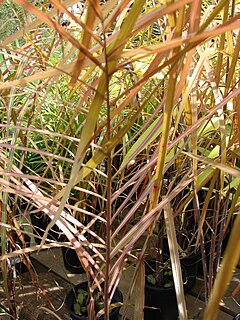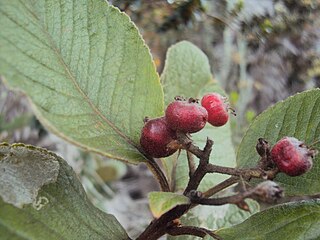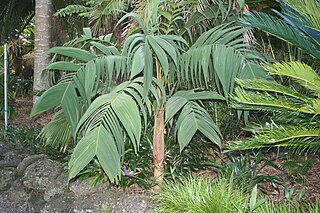
Aristotelia serrata, commonly known as wineberry or in the Māori language makomako or just mako, is a small tree in the family Elaeocarpaceae, in the genus Aristotelia, found in the North Island, South Island and Stewart Island of New Zealand.

Cutervo National Park , established in 1961, is the oldest protected area in Peru. It is located in the northern Peruvian Andes, in the region of Cajamarca. The park was extended to 8,214 hectares (31.71 sq mi) and protects areas of Andean montane forests and paramo for headwater conservation. Moreover, those areas are the habitat of animal species like the spectacled bear, the mountain tapir, and the oilbird; and plant species like the Andean wax palms.

The Tropical Andes is northern of the three climate-delineated parts of the Andes, the others being the Dry Andes and the Wet Andes. The Tropical Andes' area spans 1,542,644 km2 (595,618 sq mi).

The speckled hummingbird, is a species of hummingbird. It is the only member of the genus Adelomyia. It inhabits Neotropical montane cloud forests at elevations of 1,000–2,500 meters and is confined to the Andes of Argentina, Bolivia, Peru, Ecuador, Colombia and Venezuela; as well as to some isolated montane forest in western Ecuador and Venezuela. In Ecuador, it ranges across both eastern and western slopes of the Andes and occupies a broad altitudinal range from subtropical forests to cloud forests. In addition, one isolated population inhabits the Chongón Colonche cordillera in coastal evergreen montane forest located ca. 130 km away from the Andes.

Ceroxylon quindiuense, often called Quindío wax palm, is a palm native to the humid montane forests of the Andes in Colombia and northern Peru.

Ceroxylon is a genus of flowering plant in the family Arecaceae, native to the Andes in Venezuela, Colombia, Ecuador, Peru, and Bolivia, known as Andean wax palms.

Dypsis ambositrae is a species of flowering plant in the family Arecaceae. It is found only in Madagascar where it is threatened by habitat loss.
Aphandra is a monotypic genus of flowering plant in the palm family native to the Amazon rainforest vegetation in South America. Its only species is Aphandra natalia, sometimes called mastodon palm or fiber palm, and is used by indigenous peoples in the construction of brooms and other products. This plant is commercially exploited for its edible fruits, and for its leaf sheath and petiole fibers. This fiber is almost equal to the fiber extracted from Attalea funifera and Leopoldinia piassaba, which is called piassava.

Dictyocaryum is a monoecious genus of flowering plant in the palm family found in South America. It is closely related to the genus Iriartea; they are commonly called araque or palma real. As many as eleven species have been described but this number is reduced to three in most current accounts. The genus name translates from two Greek words meaning "net" and "nut", describing the thick network of raphe fibers around the seed.

Mauritiella is a dioecious genus of flowering plant in the palm family found in South America where it is commonly called buriti. It is named after the similar and closely related genus Mauritia.
Aiphanes deltoidea is a species of palm which is native to northeastern South America.

Quercus humboldtii, commonly known as the Andean oak, Colombian oak or roble, is a species of oak in the beech family found only in Colombia and Panamá. It is named for Alexander von Humboldt. It grows in the mountains with an altitudinal range from 1,000 to 3,200 m. It is found on all three Colombian Andean mountain ranges and some lowland inter-Andean regions.

Buddleja coriacea is a variable species endemic to the high Andes from the Cordillera Blanca in Peru to Lake Titicaca in Bolivia. It grows on dry to semi-humid rocky soils at elevations of 3,000–4,350 m, where temperatures range from -3° to 15° C. and the winds are both strong and persistent. The species was first named and described by Rémy in 1847.
Buddleja bullata is a variable species endemic to the Andes, from Venezuela south through Colombia and Ecuador to Peru, at elevations of 1,800–3,600 m, where it grows on stream beds and in the remnants of montane forest. The species was first described and named by Kunth in 1818.

Hesperomeles ferruginea is an evergreen shrub or tree in the family Rosaceae, native to montane forests on the Andes from Venezuela to Bolivia.

Vallea stipularis is a species of tree in the Elaeocarpaceae family. It is native from the Andes mountains in South America.

Licuala cattienensis, is a small fan palm, endemic to southern Vietnam. The type locality is in Cát Tiên National Park in Đồng Nai Province, growing in seasonal tropical forest in flat areas near rivers at low elevations. It is recognisable by being much smaller (<2m) and single-stemmed, in comparison the larger L. spinosa, which is common in the Park and grows in grows in clumps.

The Magdalena Valley montane forests (NT0136) is an ecoregion in the Andes mountains of central Colombia.

Geonoma undata is a species of medium-sized palm tree native to North and South America. It grows in the understory of tropical forests at high altitudes. This species has highly variable traits depending on its geographic location and several subspecies exist as a result.

Solanum pachyandrum, known as bombona, is a spine-forming vine of the Solanum genus. It is native to southwestern Ecuador and northwestern Peru where the large juicy fruit is commonly eaten and considered a treat by children. Although the plant has been known and consumed by the indigenous people of that land, it was only published scientifically in 1914 by German botanist Friedrich August Georg Bitter.

















